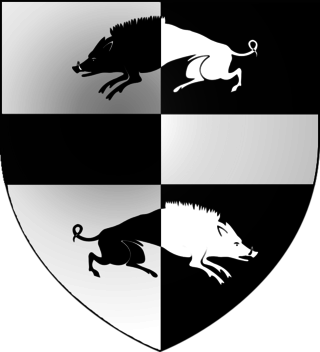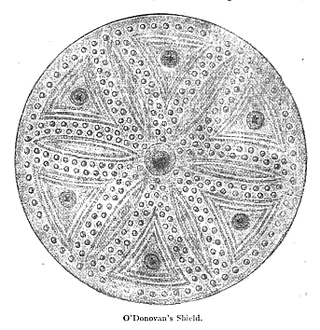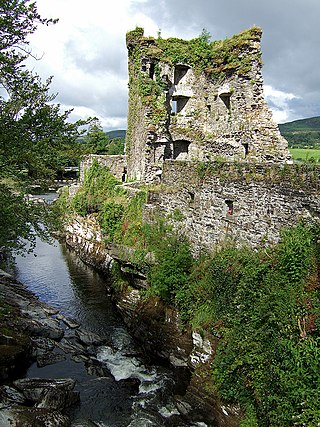
Dursey Island lies at the southwestern tip of the Beara Peninsula in the west of County Cork in Ireland. Dursey Island is 6.5 kilometres long and 1.5 kilometres wide. The island is separated from the mainland by a narrow stretch of water, Dursey Sound, which has a very strong tidal race, with the submerged Flag Rock close to the centre of the channel.

Dunboy Castle is a ruined 15th century castle on the Beara Peninsula in south-west Ireland near the town of Castletownbere. The castle's tower house and bawn were destroyed in the 1602 Siege of Dunboy, though its ruins remain open to the public.

Castletownbere is a town in County Cork in Ireland. It is located on the Beara Peninsula by Berehaven Harbour. It is also known as Castletown Berehaven.

Bantry Bay is a bay located in County Cork, Ireland. The bay runs approximately 35 km (22 mi) from northeast to southwest into the Atlantic Ocean. It is approximately 3-to-4 km wide at the head and 10 km (6.2 mi) wide at the entrance.

Beara or the Beara Peninsula is a peninsula on the south-west coast of Ireland, bounded between the Kenmare "river" to the north side and Bantry Bay to the south. It contains two mountain ranges running down its centre: the Caha Mountains and the Slieve Miskish Mountains. The northern part of the peninsula from Kenmare to near Ardgroom is in County Kerry, while the rest forms the barony of Bear in County Cork.

Bere Island or Bear Island is an island in Bantry Bay off the Beara Peninsula in County Cork, Ireland. It spans roughly 10 km x 3 km, with an area of 17.68 km² and, as of the 2022 census, had a population of 218 people.

George Carew, 1st Earl of Totnes, known as Sir George Carew between 1586 and 1605 and as The Lord Carew between 1605 and 1626, served under Elizabeth I during the Tudor conquest of Ireland and was appointed President of Munster. He was an authority on heraldry and the author of Carew's Scroll of Arms 1588, Collected from Churches in Devonshire etc., with Additions from Joseph Holland's Collection of Arms 1579.

The Beara Way is a long-distance trail in the southwest of Ireland. It is a 206-kilometre (128-mile) long circular trail around the Beara Peninsula that begins and ends in Glengarriff, County Cork, also passing through parts of County Kerry. It is typically completed in nine days. It is designated as a National Waymarked Trail by the National Trails Office of the Irish Sports Council and is managed by the Beara Tourism and Development Association.
James Archer (1550–1620) was an Irish Roman Catholic priest of the Society of Jesus who played a highly controversial role in both the Nine Years War and in the military resistance to both the House of Tudor's religious persecution of the Catholic Church in Ireland and the Elizabethan wars against both Gaelic Ireland and the Irish clans. During the final decade of the reign of Queen Elizabeth I, Fr. James Archer became a leading figure of hate in the anti-Catholic propaganda of the English government, but his most lasting achievement was his role in the establishment and strengthening of the Irish Colleges in Catholic Europe during the Counter-Reformation.

O'Sullivan is an Irish Gaelic clan based most prominently in what is today County Cork and County Kerry. According to traditional genealogy, the O’Sullivans were descended from the ancient Eóganacht Chaisil sept of Cenél Fíngin, the founder of the clan who was placed in the 9th century, eight generations removed from Fíngen mac Áedo Duib, king of Cashel or Munster from 601 to 618. Later, they became the chief princes underneath their close kinsmen, the MacCarthy dynasty, in the small but powerful Kingdom of Desmond, successor of Cashel/Munster. The last independent ruler of the clan was Donal Cam O'Sullivan Beare, who was defeated in the Nine Years' War of 1594–1603.

Donal Cam O'Sullivan Beare, Prince of Beare, 1st Count of Berehaven (1561–1618), was an Irish nobleman and soldier who was the last independent Chief of the Name of Clan O'Sullivan. He was thus the last O'Sullivan Beare, a title of the Gaelic nobility of Ireland, and Lord of the Beara Peninsula in the southwest of Ireland during the early seventeenth century, when the English Crown was attempting to secure their rule over the whole island.

Dunkerron Castle is a ruined four-storey tower house located in Templenoe, near Kenmare, County Kerry, in south-west Ireland. The castle was the family seat of the O'Sullivan Mór family from the late 16th century.
Philip O'Sullivan Beare was a military officer descended from the Gaelic nobility of Ireland, who became more famous as a writer. He fled to Habsburg Spain during the time of Tyrone's Rebellion, when the Irish clans and Gaelic Ireland were making their last stand against Tudor England. He subsequently authored the book, the Catholic History of Ireland, which offered a history from the perspective of the native Irish Catholic population.

Tuosist is a small village and civil parish in the far south of County Kerry, Ireland. It shares the Béara Peninsula with the neighbouring parishes of County Cork, and the Caha Mountains form the county border. The nearest town is Kenmare. The parish is part of the barony of Glanrought and is divided into three electoral divisions - Dawros, Ardea and Glenmore.

Dominic Collins, SJ was an Irish Jesuit lay brother, an ex-soldier, who died for his Catholic faith. He was beatified by Pope John Paul II, along with 16 other Irish Catholic Martyrs, on 27 September 1993.

Donal II O'Donovan, The O'Donovan of Clann Cathail, Lord of Clancahill, was the son of Ellen O'Leary, daughter of O'Leary of Carrignacurra, and Donal of the Skins, The O'Donovan of Clann Cathail. He is most commonly referred to as Donnell O'Donevane of Castledonovan in contemporary references of his time.

Priest's Leap is a steep and nearly straight single-lane mountain pass between Coomhola Bridge and the village of Bonane east of the more winding road from Bantry to Kenmare in Ireland. Just below the summit of the 519 m high mountain with the same name, it is the highest pass road in Munster at 463m, crossing from County Cork to County Kerry.

The Dursey massacre, also called the Dursey Island massacre, took place in June 1602 during the Nine Years' War on Dursey Island off the Beara Peninsula in southern Ireland. According to Philip O'Sullivan Beare, a group of around three hundred Gaelic Irish, including civilians, were killed by an English force under the command of George Carew.
Sir Valentine Browne, 1st Baronet, of Molahiffe, owned a large estate in south-west Ireland and was a lawyer who served as high sheriff of County Kerry.


















